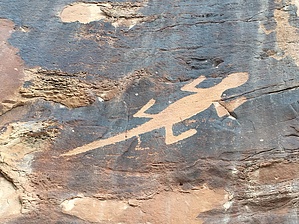| Guide | ♦ | 3 Triplogs | 0 Topics |
details | drive | permit | forecast | route |
stats |
photos | triplogs | topics | location |
| 17 | 3 | 0 |
bygone paw art by Steph_and_Blake The Cub Creek area, located on the southwest side of Dinosaur National Monument, was occupied by the Fremont Native Americans roughly a thousand years ago. More recently, it was the home of pioneer Josie Bassett Morris, a hard-working woman who built a cabin there in 1914 and lived independently for the following 50 years. Hike The location of the petroglyphs (and some pictographs) made by the Fremont peoples is noted on the National Park service map provided at the visitor center. The rock art is found on vertical sandstone walls on the north side of Cub Creek Road. Park on the south side and follow the developed trail up to the walls. The trail continues eastward for about 200 yards. There are some very fine and uncommon renderings of lizards as well as some typical anthropomorphs and sheep. There is also a flute player, but the upper part is missing.
Dinosaur NM NPS Details Petroglyphs and Pictographs The Fremont people, who lived in this area approximately a thousand years ago, left evidence of their presence in petroglyphs (patterns chipped or carved into the rock) and pictographs (patterns painted on the rock). Swelter Shelter, easy to access and located three miles from the Quarry Visitor Center, includes a variety of petroglyphs and pictographs. Petroglyph panels in the Cub Creek area feature a variety of typical Fremont designs, but are distinguished by several large lizard figures not common at other sites. Josie Bassett Morris Ranch Josephine (Josie) Bassett Morris settled in Cub Creek in 1914 and lived there independently for the next 50 years. Self-reliant and industrious, Josie built a cabin and raised livestock, field crops, vegetables, and fruits on her 1 mile by ½ mile homestead. After Josie’s death in 1964, her cabin and land became part of Dinosaur National Monument. Evidence of the life Josie Morris led can still be found at Cub Creek: a chicken coop sits not far from her recently rehabilitated cabin; remnants of the irrigation system she developed remain; fruit trees that were once part of her orchard dot the landscape. Hiking Trails The Fossil Discovery Trail passes through several layers of tilted rock in which a variety of fossils--from dinosaur bones to fish scales--are easily visible. Signs along the trail identify where fossils can be seen. Hikers can explore the desert landscape and geology of Dinosaur National Monument on the Sound of Silence Trail and the Desert Voices Trail. The River Trail, which runs alongside the Green River between Split Mountain Campground and Green River Campground, offers outstanding views of the Green River and Split Mountain. This trail is also one of the best places to birdwatch at the monument. Hog Canyon Trail and Box Canyon Trail, two short, well-shaded hiking trails, can be accessed from the parking lot near Josie Morris’s cabin. Both of these trails allow hikers to explore box canyons--canyons with steep walls on three sides and only one way in and out. Picnic Areas Picnic tables near the river are located at Split Mountain Campground. Vacant campsites at Green River Campground may also be used for picnics. Shaded picnic tables are located near the Josie Bassett Morris historic cabin at the end of the Cub Creek Road. Check out the Official Route and Triplogs. Leave No Trace and +Add a Triplog after your hike to support this local community. | |||||||||||||||||||||||||||||||||||||||||||||||||||||||||||||||||||||||||||||||||||||||||
 Route Editor
Route Editor




